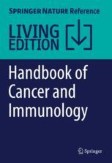Search
Search Results
-
Anti-angiogenic therapy using the multi-tyrosine kinase inhibitor Regorafenib enhances tumor progression in a transgenic mouse model of ß-cell carcinogenesis
BackgroundPancreatic neuroendocrine tumors (PNETs) represent a distinct hypervascularized tumor entity, often diagnosed at metastatic stage....

-
Muscone abrogates breast cancer progression through tumor angiogenic suppression via VEGF/PI3K/Akt/MAPK signaling pathways
BackgroundAngiogenesis strongly reflects poor breast cancer outcome and an important contributor to breast cancer (BC) metastasis; therefore,...

-
Checkpoint inhibitors and anti-angiogenic agents: a winning combination
The combination of immune checkpoint inhibitors and anti-angiogenic agents is a promising new approach in cancer treatment. Immune checkpoint...

-
Dual anti-angiogenic and anti-inflammatory action of tRNA-Cys-5-0007 in ocular vascular disease
BackgroundIntravitreal injections of angiogenesis inhibitors have proved efficacious in the majority of patients with ocular angiogenesis. However,...

-
Intrathecal Fumagillin Alleviates Chronic Neuropathy-Induced Nociceptive Sensitization and Modulates Spinal Astrocyte-Neuronal Glycolytic and Angiogenic Proteins
Nociceptive sensitization is accompanied by the upregulation of glycolysis in the central nervous system in neuropathic pain. Growing evidence has...

-
The inhibition of protein translation promotes tumor angiogenic switch
The ‘angiogenic switch’ is critical for tumor progression. However, the pathological details and molecular mechanisms remain incompletely...

-
Angiogenic and molecular diversity determine hepatic melanoma metastasis and response to anti-angiogenic treatment
BackgroundCutaneous melanoma exhibits heterogeneous metastatic patterns and prognosis. In this regard, liver metastasis, which is detected...

-
Notch1 and Notch4 core binding domain peptibodies exhibit distinct ligand-binding and anti-angiogenic properties
The Notch signaling pathway is an important therapeutic target for the treatment of inflammatory diseases and cancer. We previously created...

-
Fasting mimicking diet inhibits tumor-associated macrophage survival and pro-tumor function in hypoxia: implications for combination therapy with anti-angiogenic agent
BackgroundRecent research shows that tumor-associated macrophages (TAMs) are the primary consumers of glucose in tumor tissue, surpassing that of...

-
Immune Checkpoint Inhibitors and Anti-Angiogenic Therapy for Cancer
The development of increased knowledge of the interaction between cancer cells, immune cells, and the tumor microenvironment is of special interest...
-
Circulating endothelial and angiogenic cells predict hippocampal volume as a function of HIV status
Circulating endothelial cells (CECs) and myeloid angiogenic cells (MACs) have the capacity to stabilize human blood vessels in vivo. Evidence...

-
Phenotypic screening in Organ-on-a-Chip systems: a 1537 kinase inhibitor library screen on a 3D angiogenesis assay
Modern drug development increasingly requires comprehensive models that can be utilized in the earliest stages of compound and target discovery. Here...

-
Sildenafil, a phosphodiesterase-5 inhibitor, stimulates angiogenesis and bone regeneration in an atrophic non-union model in mice
Non-union formation represents a major complication in trauma and orthopedic surgery. The phosphodiesterase-5 (PDE-5) inhibitor sildenafil has been...

-
Molecular differences of angiogenic versus vessel co-opting colorectal cancer liver metastases at single-cell resolution
BackgroundColorectal cancer liver metastases (CRCLM) are associated with a poor prognosis, reflected by a five-year survival rate of 14%....

-
Oral formulation of Wnt inhibitor complex reduces inflammation and fibrosis in intraperitoneal implants in vivo
The use of implantable biomaterials to replace physiological and anatomical functions has been widely investigated in the clinic. However, the...

-
Circular RNA circFIRRE drives osteosarcoma progression and metastasis through tumorigenic-angiogenic coupling
BackgroundDisappointing clinical efficacy of standard treatment has been proven in refractory metastatic osteosarcoma, and the emerging...

-
Efficacy and safety of PD-1/PD-L1 inhibitors combined with anti-angiogenic therapy for the unresectable hepatocellular carcinoma and the benefit for hepatitis B virus etiology subgroup: a systematic review and meta-analysis of randomized controlled trials
BackgroundHepatocellular carcinoma (HCC) is the third leading cause of cancer-related death, worldwide. The predominant causative factor for HCC is...

-
Dual anti-angiogenic and anti-metastatic activity of myriocin synergistically enhances the anti-tumor activity of cisplatin
PurposeTumor microenvironment consists of various kind of cells, forming complex interactions and signal transductions for tumor growth. Due to this...

-
Alpinumisoflavone against cancer pro-angiogenic targets: In silico, In vitro, and In ovo evaluation
BackgroundBreast cancer is currently the world’s most predominant malignancy. In cancer progression, angiogenesis is a requirement for tumor growth...

-
Targeting FSCN1 with an oral small-molecule inhibitor for treating ocular neovascularization
BackgroundOcular neovascularization is a leading cause of blindness and visual impairment. While intravitreal anti-VEGF agents can be effective, they...

